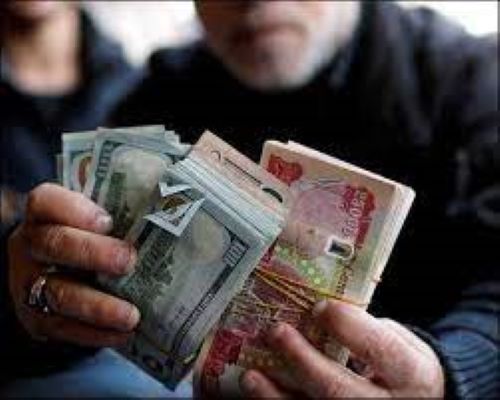By Our Correspondent
NEW DELHI – The decline of Iraqi dinar below the official exchange rate with the U.S. dollar, following its continuous devaluation, has upset financial markets in the Middle-Eastern country and led to huge public protests outside the Central Bank of Iraq in Baghdad. The U.S. has blacklisted 14 Iraqi banks and banned them from conducting dollar transactions.
The Iraqi banks have called upon the government to intervene and warned that the U.S. action will further hurt the dinar and adversely affect foreign investments in Iraq. During the last one week, the dollar’s value has gone up from 1,470 dinars to 1,570 dinars, which will lead to inflation and create difficulties for common people, who are reeling under the impact of sanctions and have witnessed a significant decline in their purchasing power.
The Iraqi dinar traded against the U.S. dollar at a rate of 1,200 to one for several years until 2020, when Iraq lowered the rate to 1,460 because of decreased oil prices and a liquidity crisis. The U.S. Federal Reserve began exercising greater scrutiny over Iraq due to smuggling of dollars to Iran late last year, and this caused the dinar to sink further below the official rate. In February this year, the Central Bank of Iraq revised the official rate to 1,300 dinars to the dollar.
The Iraqi currency fell after new action by the U.S. government to curb the flow of dollars to Iran, which is facing sanctions from the U.S. covering its financial sector. The U.S. Treasury Department and the Federal Reserve Bank of New York have taken the decision to bar 14 Iraqi banks from dollar transactions. Restriction on U.S. dollars will limit the currency’s supply and increase its value against the dinar.
The Central Bank of Iraq has stated that the barred banks can still conduct business in Iraqi dinars, while pointing out that these banks only constitute 8% of foreign transfers. Central Bank Governor Ali al-Allaq said there was no indication from the U.S. government of further action against Iraqi banks and termed the fall in the dinar’s value temporary.
Haider Al Shamma, a representative of the banks, said the banks had nothing to do with political tensions and they were independent financial institutions. The banks have warned that the action could further hurt the dinar and foreign investment in Iraq.
In January this year, Iraq’s Prime Minister Mohammed Shia al-Sudani had replaced the Central Bank’s Governor following the currency’s plunge for several weeks, when the Governor, Mustafa Ghaleb Mukheef, himself announced that he no longer wished to stay on the job. Mukheef, who was at the Governor’s post since 2020, was replaced by Muhsen al-Allaq.
The drop in Iraqi dinar’s value coincides with efforts to make Iraq’s banking system compliant with the Society for Worldwide Interbank Financial Telecommunication (SWIFT) international electronic transfer system. These steps, which began in mid-November last year, were required for accessing Iraqi funds held in the U.S.
Some Iran-backed politicians in Iraq have blamed the drop on recent measures by the U.S. Treasury. The U.S. has sanctioned several Iraqi banks dealing mainly with Iran amid concerns that hard currency is being routed from Iraq to Iran. Late last year, the U.S. Federal Reserve began taking measures on transactions to slow down the flow of dollars into Iraq.
Discussions between the U.S. Federal Reserve and the Central Bank of Iraq to reform the currency sale window and end pervasive fraud and smuggling operations have been ongoing for some time. International pressure has also been laid on Iraq to modernise, automate and reform its financial and banking system.
Despite the Central Bank of Iraq’s emphasis on technical nature of the problem, the decline of the Iraqi dinar’s value has triggered a political and social backlash. The largest social group that drives market activity comprises government employees, wage earners and recipients of state-sponsored social welfare. The decline in the dinar’s value has led to an economic downturn in some sectors, while the currency speculation market and some banks and exchange companies attempted to use their dollar holdings to manipulate the currency’s supply and increase their profits.
The dollar’s dominance is slowly declining in the entire Middle East. Saudi Arabia, United Arab Emirates (UAE) and Egypt have shown willingness for doing transactions in Chinese yuan, Japanese yen and Indian rupee. Several countries have also evinced interest in joining BRICS, a grouping of the world economies of Brazil, Russia, India, China and South Africa, which will upset the dollar and also generate new political equations in the Middle-East.
India and the UAE have recently signed an agreement for rupee-dirham transaction, though it was done hurriedly during Prime Minister Narendra Modi’s stopover in Dubai without proper homework and research by financial experts. The pact is expected to help in increasing the circulation of rupee in the Gulf region as well as in internationalisation of the Indian currency.
The two major reasons for the desire of the Middle-Eastern countries to use other currencies are Russia’s war in Ukraine and the impression that the U.S. is trying to rewrite the rules of the global oil market. However, even if some countries want to bypass the U.S. dollar as a currency, it will be more difficult to replace the settlement infrastructure provided by the dollar-driven system.





